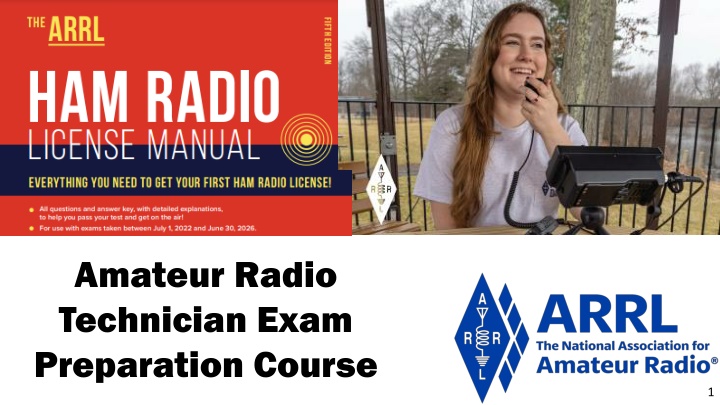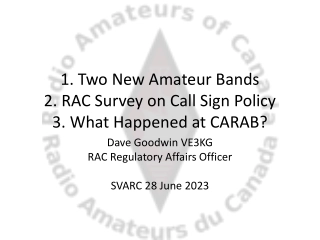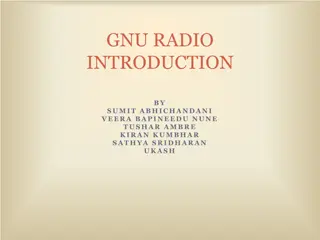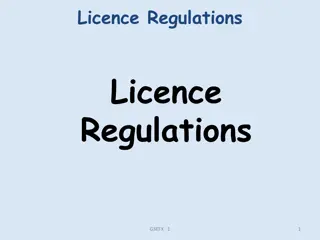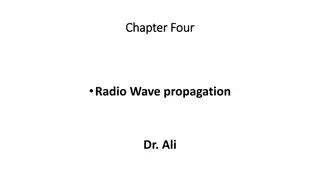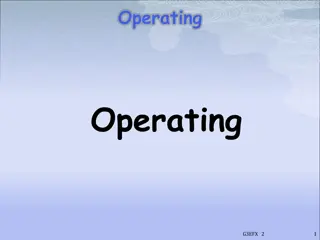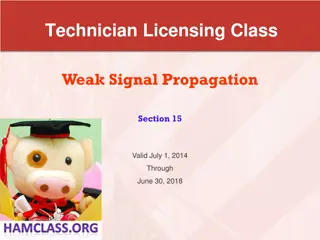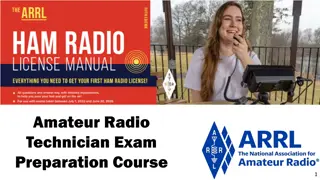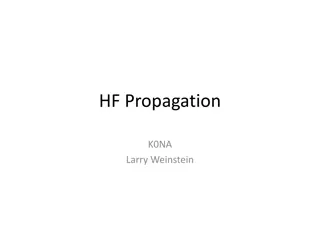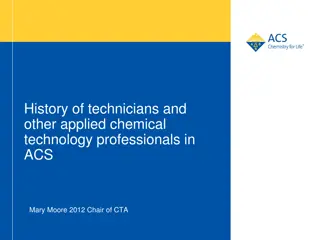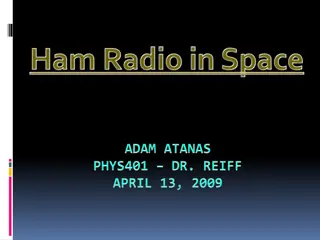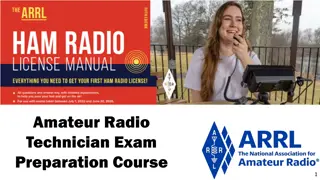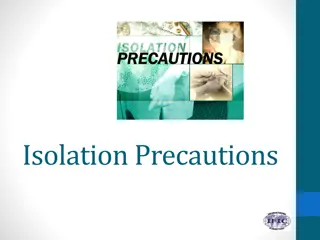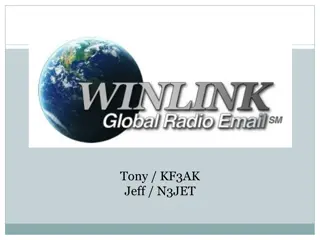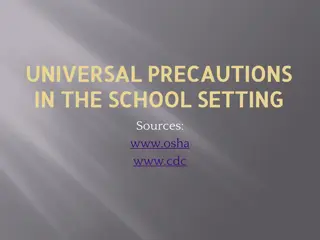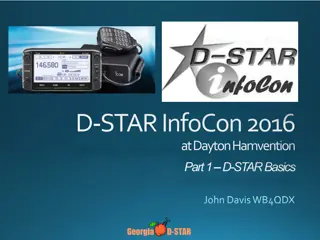Electrical Safety Precautions for Amateur Radio Technicians
This course module covers essential safety practices for amateur radio technicians, focusing on electrical safety, RF management, and avoiding electrical hazards. Learn about the dangers of electrical injuries, tips for working with power, AC safety grounding, and lightning protection measures for your equipment. By following these guidelines, you can ensure a safe operating environment while pursuing your amateur radio activities.
Download Presentation

Please find below an Image/Link to download the presentation.
The content on the website is provided AS IS for your information and personal use only. It may not be sold, licensed, or shared on other websites without obtaining consent from the author.If you encounter any issues during the download, it is possible that the publisher has removed the file from their server.
You are allowed to download the files provided on this website for personal or commercial use, subject to the condition that they are used lawfully. All files are the property of their respective owners.
The content on the website is provided AS IS for your information and personal use only. It may not be sold, licensed, or shared on other websites without obtaining consent from the author.
E N D
Presentation Transcript
Amateur Radio Technician Exam Preparation Course 1
Amateur Radio Technician Exam Prep Course Module 9 Safety 9.1 Electrical Safety 9.2 Managing RF in Your Station 9.3 RF Interference (RFI) 9.4 RF Exposure 9.5 Mechanical Safety 2 2
Electrical Injuries Electrical current through the body can disrupt the electrical function of cells Can cause involuntary muscle contractions Large currents can burn the skin and heat tissue 3 3
Avoiding Electrical Hazards Safety tips for working with power ON Keep one hand in your pocket Wear insulating shoes Never bypass a safety interlock during testing Make sure capacitors are discharged Keep metal objects clear of storage battery terminals Avoid working on equipment with the battery connected Remove unnecessary jewelry from your hands Avoid working alone 4 4
AC Safety Grounding The safety ground is a connection to the power system s ground reference connection in your main electrical service box The ground connection causes a fuse or circuit breaker to remove power from the equipment Grounding guidelines Use three-wire power cords and plugs Make sure all equipment has a connection to the ground Use ground fault circuit interrupter (GFCI) circuit breakers/outlets Verify AC wiring is done properly Never replace a fuse or circuit breaker with one of a larger size Don t overload single outlets 5 5
AC Safety Grounding (cont.) When wiring circuits, be sure to follow the US standard Hot black wire (occasionally red) Neutral white wire Safety or equipment ground green Use cable and wire sufficiently rated for the expected current load Use the proper size fuses and circuit breakers Be sure fuses or circuit breakers are installed in series with the hot conductor or conductors 6 6
Lightning Protection Lightning protection is intended to provide fire protection for your home Starting at your antennas, all towers, masts, and antenna mounts should be grounded according to local building and electrical codes Connections are made at the tower base though a large-diameter wire to a ground rod Ground connections should be as short and direct as possible avoid sharp bends Use lightning arrestors grounded to a common plate that is in turn connected to a nearby external ground All ground rods and earth connections must be bonded together with heavy wire 7 7
What health hazard is presented by electrical current flowing through the body? A. It may cause injury by heating tissue B. It may disrupt the electrical functions of cells C. It may cause involuntary muscle contractions D. All these choices are correct T0A02 D 9-2 9 9
What hazard exists in a power supply immediately after turning it off? A. Circulating currents in the dc filter B. Leakage flux in the power transformer C. Voltage transients from kickback diodes D. Charge stored in filter capacitors T0A11 D 9-2 10 10
In the United States, what circuit does black wire insulation indicate in a three-wire 120 V cable? A. Neutral B. Hot C. Equipment ground D. Black insulation is never used T0A03 B 9-4 11 11
What is a good way to guard against electrical shock at your station? A. Use three-wire cords and plugs for all AC powered equipment B. Connect all AC powered station equipment to a common safety ground C. Install mechanical interlocks in high-voltage circuits D. All these choices are correct T0A06 D 9-4 12 12
Where should a fuse or circuit breaker be installed in a 120V AC power circuit? A. In series with the hot conductor only B. In series with the hot and neutral conductors C. In parallel with the hot conductor only D. In parallel with the hot and neutral conductors T0A08 A 9-4 13 13
Where should a lightning arrester be installed in a coaxial feed line? A. At the output connector of a transceiver B. At the antenna feed point C. At the ac power service panel D. On a grounded panel near where feed lines enter the building T0A07 D 9-5 14 14
What should be done to all external ground rods or earth connections? A. Waterproof them with silicone caulk or electrical tape B. Keep them as far apart as possible C. Bond them together with heavy wire or conductive strap D. Tune them for resonance on the lowest frequency of operation T0A09 C 9-5 15 15
Which of the following is good practice when installing ground wires on a tower for lightning protection? A. Put a drip loop in the ground connection to prevent water damage to the ground system B. Make sure all ground wire bends are right angles C. Ensure that connections are short and direct D. All these choices are correct T0B01 C 9-5 16 16
Which of the following is true when installing grounding conductors used for lightning protection? A. Use only non-insulated wire B. Wires must be carefully routed with precise right-angle bends C. Sharp bends must be avoided D. Common grounds must be avoided T0B10 C 9-5 17 17
Which of the following establishes grounding requirements for an amateur radio tower or antenna? A. FCC Part 97 rules B. Local electrical codes C. FAA tower lighting regulations D. UL recommended practices T0B11 B 9-5 18 18
Managing RF in Your Station Your station wiring, feed lines, power connections, and other cables all pick up RF from your transmitted signal It is not practical to ground RF current in the same way as for AC power and lightning protection Best approach is to bond all of the equipment together Keeps all of your equipment at the same voltage so that RF current does not flow between the different pieces RF current on cables and enclosures can cause audio distortion, erratic operation of computer equipment, and even RF burns RF feedback via a microphone cable can cause distorted transmitted audio 19 19
Bonding Tips Bond all metal equipment enclosures to a common RF ground bus Use short, wide conductors such as copper flashing or strap or heavy solid wire Solid strap is best because it presents the lowest impedance to RF Keep all connections, straps and wires as short and direct as possible Connect the ground bus to your AC safety ground and any earth connections See Figure 9.2 in text 20 20
RF Interference (RFI) and Filters Interference between appliances and ham radio is called radio frequency interference (RFI) Filters are used to Prevent unwanted signals from being radiated Keep unwanted signals from being received AC power line filters keep RF signals from passing into or out of equipment via the hot and neutral conductors of the AC power connection They reject all signals with frequencies greater than a few kHz Ferrite chokes are also used to reduce RF current on the outside of shielded audio, microphone, and computer cables. 21 21
Filters (cont.) 22 22
Interference from Amateur Transmissions The most common causes of RFI from your transmissions are fundamental overload, harmonics, and spurious emissions Very strong signals may overwhelm a receiver s ability to reject them This is called fundamental overload Consumer equipment is often unable to reject strong signals outside the bands it is intended to receive A high-pass filter can be connected at antenna input of FM & TV receivers to reject strong lower-frequency signals from amateur HF signals Broadcast-reject filters attenuate signals from nearby AM, FM, or TV broadcast stations 23 23
Harmonics, Spurious Emissions & Leakage Every transmitter s RF output signal contains weak harmonics of the desired output signal and other spurious emissions that can cause interference to nearby equipment A low-pass or band-pass filter can be installed at the transmitter s connection to the antenna feed line to prevent harmonics Leakage is another source of interference The most common cause of leakage is faulty coaxial connectors on the cable feed line Be sure the connectors are installed correctly and attached tightly 24 24
Good Practices in Your Station Regardless of the source, you can reduce or eliminate much interference by making sure your own station follows good amateur practices for grounding and filtering Make sure your station is in good working order with appropriate grounding, filtering, and good quality connections Use shielded wire and shielded cables to prevent coupling with unwanted signals and undesired radiation be sure to connect the shield properly Eliminate interference to your own home appliances and televisions first 25 25
RFI and Neighbors Start by making sure it s really your transmissions that are causing the problem Offer to help determine the nature of interference If you re the recipient of the RFI Make sure your station meets the standards of good amateur practices Offer to help determine the source of interference You may have to politely explain to the neighbor that FCC rules prohibit them from using a device that causes harmful interference Be diplomatic in dealing with your neighbors 26 26
Which of the following conductors is preferred for bonding at RF? A. Copper braid removed from coaxial cable B. Steel wire C. Twisted-pair cable D. Flat copper strap T4A08 D 9-6 28 28
What is a symptom of RF feedback in a transmitter or transceiver? A. Excessive SWR at the antenna connection B. The transmitter will not stay on the desired frequency C. Reports of garbled, distorted, or unintelligible voice transmissions D. Frequent blowing of power supply fuses T7B11 C 9-6 29 29
Which of the following could you use to cure distorted audio caused by RF current on the shield of a microphone cable? A. Band-pass filter B. Low-pass filter C. Preamplifier D. Ferrite choke T7B04 D 9-7 30 30
Which of the following can cause radio frequency interference? A. Fundamental overload B. Harmonics C. Spurious emissions D. All these choices are correct T7B03 D 9-8 31 31
What would cause a broadcast AM or FM radio to receive an amateur radio transmission unintentionally? A. The receiver is unable to reject strong signals outside the AM or FM band B. The microphone gain of the transmitter is turned up too high C. The audio amplifier of the transmitter is overloaded D. The deviation of an FM transmitter is set too low T7B02 A 9-8 32 32
How can fundamental overload of a non-amateur radio or TV receiver by an amateur signal be reduced or eliminated? A. Block the amateur signal with a filter at the antenna input of the affected receiver B. Block the interfering signal with a filter on the amateur transmitter C. Switch the transmitter from FM to SSB D. Switch the transmitter to a narrow-band mode T7B05 A 9-8 33 33
Which of the following can reduce overload of a VHF transceiver by a nearby commercial FM station? A. Installing an RF preamplifier B. Using double-shielded coaxial cable C. Installing bypass capacitors on the microphone cable D. Installing a band-reject filter T7B07 D 9-8 34 34
What should be the first step to resolve non-fiber optic cable TV interference caused by your amateur radio transmission? A. Add a low-pass filter to the TV antenna input B. Add a high-pass filter to the TV antenna input C. Add a preamplifier to the TV antenna input D. Be sure all TV feed line coaxial connectors are installed properly T7B09 D 9-10 35 35
Which of the following is a reason to use shielded wire? A. To decrease the resistance of DC power connections B. To increase the current carrying capability of the wire C. To prevent coupling of unwanted signals to or from the wire D. To couple the wire to other signals T6D03 C 9-9 36 36
Which of the following actions should you take if a neighbor tells you that your station s transmissions are interfering with their radio or TV reception? A. Make sure that your station is functioning properly and that it does not cause interference to your own radio or television when it is tuned to the same channel B. Immediately turn off your transmitter and contact the nearest FCC office for assistance C. Install a harmonic doubler on the output of your transmitter and tune it until the interference is eliminated D. All these choices are correct T7B06 A 9-9 37 37
What should you do if something in a neighbors home is causing harmful interference to your amateur station? A. Work with your neighbor to identify the offending device B. Politely inform your neighbor that FCC rules prohibit the use of devices that cause interference C. Make sure your station meets the standards of good amateur practice D. All these choices are correct T7B08 D 9-10 38 38
RF Exposure With its relatively low frequency, RF energy is non-ionizing radiation RF radiation is not the same as ionizing radiation from radioactivity because the energy in signals at radio frequencies is far too low to cause an electron to leave an atom (can t cause genetic damage) Per FCC rules the station licensee is responsible for ensuring that no one is exposed to RF energy above the FCC exposure limits Heating as a result of exposure to RF fields is caused by the body absorbing RF energy Absorption varies with frequency because the body absorbs more RF energy at some frequencies than others RF burns can be eliminated by proper bonding techniques or by preventing access to an antenna 39 39
Exposure Limits Figure 9.5 Maximum Permissible Exposure (MPE) limits vary with frequency because the body responds differently to energy at different frequencies. The controlled and uncontrolled limits refer to the environment in which people are exposed to the RF energy. 40 40
Exposure Limits (refer to previous slide) People in controlled environments are aware of their exposure and can take the necessary steps to minimize it People in uncontrolled environments are not aware of their exposure, (areas open to the general public or your neighbor s property) Frequencies at which the body has the highest absorption rate are from 30 to 1500 MHz (see graph) 41 41
Averaging and Duty Cycle MPE limits are based on averages, not peak exposure, allowing exposure to be averaged over fixed time intervals Transmitters only generate RF for a fraction of the time they operate (only when transmitting they receive or sit idle the remaining time) This lowers the duty cycle of the emissions the ratio of the transmitted signal s on-the-air time to the total operating time Duty cycle must be considered when evaluating exposure Because the signal is only present for about the time (50% duty cycle), the signal power can be twice as high and still have the same average power as transmitting continuously with a duty cycle of 100% 42 42
Evaluating Exposure All fixed stations must perform an exposure evaluation three ways of making this evaluation Use the techniques outlined in the FCC s OET (Office of Engineering Technology) Bulletin 65 Measure the power density of your transmissions Make computer models of your station You only need to re-evaluate if you change equipment in your station that affects average output power The following web page lists resources that make the job a lot easier (http://www.arrl.org/fcc-rf-exposure-regulations-the-station- evaluation) You ll need information on the RF signal s frequency and power level, distance from the antenna and the antenna s radiation pattern 43 43
Exposure Safety Measures Locate antennas away from where people can get close to them Raise the antenna Avoid pointing beam antennas where people are likely to be Use a lower gain antenna to reduce radiated power density or reduce transmitter power Limit the average power of your transmissions Place mobile antennas on the roof or trunk of the car (maximizes shielding) Use a remote microphone to hold a handheld transceiver away from your head 44 44
What type of radiation are radio signals? A. Gamma radiation B. Ionizing radiation C. Alpha radiation D. Non-ionizing radiation T0C01 D 9-11 46 46
Why do exposure limits vary with frequency? A. Lower frequency RF fields have more energy than higher frequency fields B. Lower frequency RF fields do not penetrate the human body C. Higher frequency RF fields are transient in nature D. The human body absorbs more RF energy at some frequencies than at others T0C05 D 9-11 47 47
What hazard is created by touching an antenna during a transmission? A. Electrocution B. RF burn to skin C. Radiation poisoning D. All these choices are correct T0C07 B 9-11 48 48
How does RF radiation differ from ionizing radiation (radioactivity)? A. RF radiation does not have sufficient energy to cause chemical changes in cells and damage DNA B. RF radiation can only be detected with an RF dosimeter C. RF radiation is limited in range to a few feet D. RF radiation is perfectly safe T0C12 A 9-11 49 49
Who is responsible for ensuring that no person is exposed to RF energy above the FCC exposure limits? A. The FCC B. The station licensee C. Anyone who is near an antenna D. The local zoning board T0C13 B 9-11 50 50
